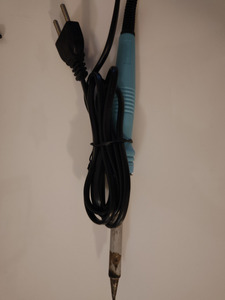boby wrote on 2024-01-02, 14:19:
I do have a paste flux, not the one from soldering wire.
Flux would leave your soldering joints look smooth and shiny, not jagged mess. There are Chinese flux-adjacent products that look the part but dont work, there are also counterfeits. My guess is you set temp to high and all flux burned off before it had a chance to do its magic.
boby wrote on 2024-01-02, 14:19:
So my iron is garbage? What should I buy? I know how to spend $500 but I would like not to.
Its a clone (cough counterfeit) of a design from 1979. You need to learn what it can and cant do to use it properly. You cant just set temperature and mimic what you see in soldering tutorials, that will work for soldering speaker wires or single sided PCB but not on modern PCBs with ground planes.
There are cheap, as in $15-50, Chinese knockoffs of modern cartridge based stations. Anything using JBC/T12 tips should be light years better. Even the worst counterfeit Chinese "hakko" T12 cartridge (and those sell for $2-4) combined with $15 "T12 OLED Digital Soldering Iron Station Temperature Controller Board for HAKKO" is always going to be better than 50 year old design genuine Hakko 903 tip, not to mention Chinese knockoff 903 made using worn off machines leading to bad fit/huge gaps between heater and tip.
boby wrote on 2024-01-02, 14:19:
Btw. My board is from 90's, so not too modern. 🙂
Its multilayer, thats the main difference. More layers more thermal mass, PCB sucks heat out of the tip of soldering iron and radiates it away with all its surface. Good soldering station (Oki/Metcal, JBC, T12 Hakkos) will detect drop in temperature quickly and start pumping more power immediately. Bad station like yours has a huge distance and bad thermal connectivity between part being soldered and actual temperature sensor in the heater, that means as soon as you touch something on modern PCB your super hot tip gets cold and stops melting solder, so you crank it even higher making the tip burn parts/pcb/flux.
boby wrote on 2024-01-02, 14:19:
I was using small tip on my iron. Thx for the advice.
thats the biggest error everyone makes, intuition always says small solder point should use small tip 😀
Use big flat chisel tip, use more flux, set temperature lower so the flux doesnt instantly burn away. You should be able to keep your hot iron inside a puddle of flux and not have it evaporate.
boby wrote on 2024-01-02, 14:19:
I also have some cheep 50W soldering iron. Is it better then the current one?
its good for wood carving 😀



